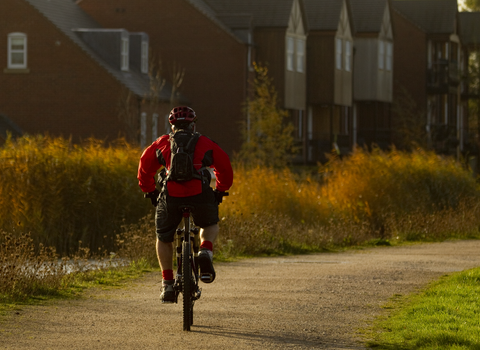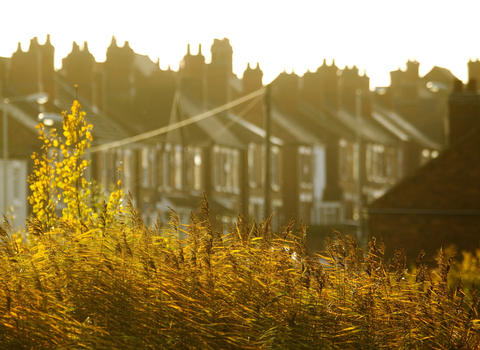Many people come to the Trust hoping that we will be able to help them object to a planning application.
Sadly we do not have resources to get involved with the thousands of applications submitted in the county every year. Our aim is to try to head off any conflicts with wildlife before an application is submitted and where possible achieve improvements for wildlife.
We do this by lobbying for strong wildlife policies in Local Plans and sometimes by working with developers who have plans for allocated sites.
Objecting to a planning application?
We are not anti-development and try to ensure that local authority policies relating to wildlife are robust and that local authorities have the necessary expertise in-house to deal with planning issues affecting wildlife.
At present the latter varies between local authorities across the county but all have the same duty to conserve and where possible enhance biodiversity via the planning process.
Our aim is to try to head off any conflicts with wildlife before an application is submitted and where possible achieve improvements for wildlife. We do this by lobbying for strong wildlife policies in Local Plans and sometimes by working with developers who have plans for allocated sites.
In this way we can not only reduce or eliminate impacts on wildlife, we can also push for enhancements and habitat creation.
Things to consider when objecting a planning application
1. Wildlife issues rarely stop planning proposals
While many local people and protest groups may not want a particular development in their locality, regrettably wildlife issues rarely prevent a development from going ahead. However, wildlife concerns can alter the layout or scale of a proposal.
While it might seem unsatisfactory, it is established practice now for impacts on wildlife to be mitigated in some way. Even impacts on protected species such as bats and great crested newts are routinely dealt with through mitigation schemes.
Standing Advice is issued by Natural England for local authorities on how to mitigate impacts of development on protected species.
2. An application is far more likely to be consented if it is for a site allocated in the relevant Local Plan
Other factors such as flood risk, highway access issues and impact on landscape are more likely to result in a planning application being turned down than impacts on wildlife.
The likelihood of a local authority approving an application will also be determined by the status of their Local Plan and whether they have already approved sites for residential and built development in their area.
Once in an adopted Local Plan which has passed through its Examination in Public it is more or less inevitable that an application for an allocated site will be consented.
You can check the status of the Local Plan for your area here:
3. Green Field sites are not necessarily of high ecological value
Sites which might be perceived to have a high wildlife value are often actually of low wildlife interest.
The majority of “greenfield” sites which are proposed for development have previously been intensively farmed and support little in the way of wildlife, although they may be important in landscape terms or have established hedgerows.
Unless the majority of the site is high value habitat such as unimproved flower-rich grassland or ancient woodland (say of SSSI quality), or is crucial for key species it is unlikely to be considered a constraint to development.
4. The majority of common species we see around us every day have no relevance in the planning system
Foxes, squirrels, etc. are not “material considerations”. Birds are not generally a constraint unless they are confirmed as breeding on the site and then the constraint only relates to site clearance – i.e. not between March and August.
If key species are shown to be present (great crested newt, dormouse, bats, reptiles, etc.) they would normally be dealt with through a mitigation scheme.
5. Check that an Environmental Statement has been submitted with the application you are concerned about
Applications for many planning proposals are usually accompanied by an ecological assessment prepared by a professional ecological consultant in accordance with the Institute of Ecology and Environmental Management guidelines. These guidelines are robust; in line with UK and European legislation and considered appropriate by the Wildlife Trusts.
These reports are key and will be used by the local authority to assess the site’s ecological value. They may also be the basis for a subsequent mitigation scheme.
If you think that a proposed application site is important for wildlife you should first check that an ecological report has been submitted with the application. You can view this on the local authority’s planning portal.
6. If you have records of wildlife for the site you are concerned about you should include these in your representation to the local authority
In most cases if there is evidence of wildlife interest on an application site the local authority will request a survey report and the local authority will not determine the application until they have all the relevant information. If a report has not been submitted you should alert the relevant case officer to your concerns
7. Make sure the Ecological Statement is accurate
If an ecological report has been submitted you should check to see if the particular habitat or species you are concerned about has been mentioned in the report and how the applicant proposes to deal with this. If any impact identified or mitigation suggested is in line with the relevant Natural England Standing Advice the local authority will most likely accept the mitigation and ensure its implementation is made a condition of any consent. If you think that the ecological report is incorrect or has missed, or underplayed, a key wildlife issue; or that the mitigation proposed is insufficient or will be ineffective, you should alert the case officer to your concerns with as much supporting evidence as possible.
The planning system often struggles to deal effectively with wildlife issues. The best chance of defeating a planning application which impacts on wildlife is to demonstrate that the proposed mitigation is unlikely to be successful.
A big concern for the Wildlife Trusts is that mitigation – which is now the accepted default position – is rarely monitored so we have little evidence that any of it is actually works. The Trust is currently researching mitigation schemes for great crested newts and we will report on this in due course.
In the meantime, when commenting on planning applications which propose mitigation our default position is to ask the relevant local authority to request of the applicant that the mitigation that they are proposing has been shown to work elsewhere. We encourage as many people as possible who are commenting on schemes to do the same.

(c) Ben Hall/2020VISION
Contacting us about a planning application
After considering the information above and having followed the advice it contains, if you think that there is an application which is likely to have a significant impact on wildlife please contact the Trust at info@gloucestershirewildlifetrust.co.uk with the following information:
- Local Authority area
- Planning application reference number
- Nature of your concern
We cannot guarantee to be able to look at every planning application we are alerted to but we will do our best to look into those which appear to be a threat to the county’s wildlife. We are unable to investigate proposals for built development until a planning application has been submitted.

